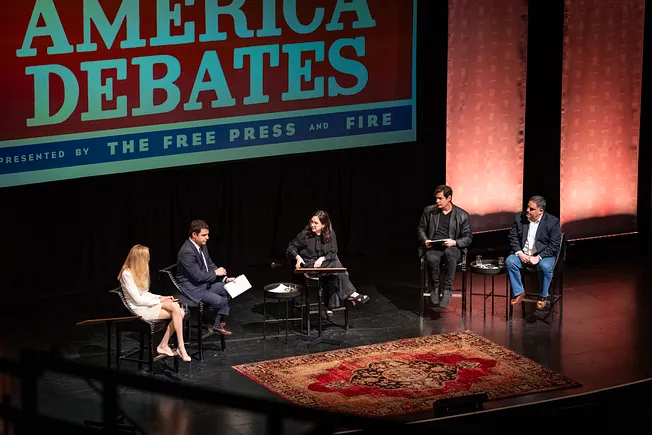I’d been reading for months about “supply chain” problems, but it all remained a little abstract until I went to a furniture store hoping to buy a new couch. The exhausted salesman didn’t bother getting up. Nothing until June, he told us. This was in early October.
Despite years working at the Wall Street Journal editorial page, in which I edited hundreds of op-eds about quantitative easing, economics have never been my forte. In part that’s because find so much economic writing hard to read—boring or confusing or otherwise full of jargon and acronyms that make my eyes glaze over.
Economic writing these days is especially bad. That’s because many of the smart mainstream finance writers are trapped into boosting the president’s agenda. So problems have to be either too complicated to possibly explain (trust the experts!) or else very simple (inflation fears are hysterical and there’s no real supply chain problem).
There are at least two major exceptions. Marginal Revolution, Tyler Cowen and Alex Tabarrok’s excellent blog, and The Grumpy Economist by John Cochrane, who is a senior fellow at the Hoover Institution at Stanford University.
We just recorded a podcast with Tyler about the state of the economy—that’ll be out soon—but on the occasion of Black Friday, I thought to ask John: what is really going on with the economy?
Why has the cost of basic goods like gas and beef and milk skyrocketed? Is there anything that can be done to reverse the trend? And should I hold off buying that fancy Dutch Oven? Or leap on whatever deal I can find online right now?
Read John’s piece before you make those tough calls. And may we humbly suggest that at $5 a month, a subscription to Common Sense is quite a Black Friday bargain.
Happy deal-hunting to one and all.
— BW
Black Friday begins tonight, and Americans, after emerging from our collective turkey coma, will dive into our sacred, national ritual: shopping.
Those who haven’t shopped lately are in for a rude awakening: Many items will be out of stock, delayed or cost a lot more than they used to. Welcome to inflation, back from the 1970s!
As you look for a deal on a Peloton to work off your pandemic paunch, here is a brief explanation about what’s going on with our economy, why so many things are becoming more expensive, why this hurts all of us, and why the government can’t spend its way out of this mess.
Why are prices rising?
The news is full of “supply chain” problems. Shipping containers can’t get through our ports. Car-makers can’t get chips to make cars. Railroads look like the 405 at rush hour.
What’s underlying many of these problems is the fact that businesses can’t find enough workers. There aren’t enough truck drivers, airline pilots, construction workers and warehouse workers in the “supply chain.” Restaurants can’t find waiters and cooks. There are 10 million job openings and only seven million people looking for work. About three million people who were working in March 2020 are no longer working or looking for work.
But supply chains wouldn’t be clogged if people weren’t trying to buy a lot. The fundamental issue is that demand is outstripping supply.
Strawberry prices go up in the fall because the supply is lower; apples are cheap, because they are abundant. Prices of one good relative to another change, and induce us to shop effectively.
That’s normal.
Inflation is different. Inflation describes all prices and wages going up at the same time, straining supply throughout the economy. That’s the situation right now. Even the Dollar Tree stores just became the buck and a quarter stores, raising all prices 25%.
What’s driving current inflation?
Widespread inflation always comes from people wanting to buy more of everything than the economy can supply. Where did all that demand come from? In its response to the pandemic, the U.S. government created about 2.5 trillion new dollars, and sent checks to people and businesses. It borrowed another $2.5 trillion, and sent more checks to people and businesses. Relative to a $22 trillion economy, and $17 trillion of existing (2020) federal debt, that’s a lot of money.
People are now spending this money, the economy can’t keep up, and prices are rising. Milton Friedman once joked that the government could easily create inflation by dropping money from helicopters. That’s pretty much what our government did.
(I do not here argue the wisdom of this policy. The government helped a lot of people and businesses to get through the lockdowns. One can quibble that money could have been distributed more thoughtfully, but we’re here to think about inflation, not Covid policy.)
What’s wrong with inflation?
Prices and wages all rising at the same rate doesn’t sound so bad. But it’s never that simple. Inflation is chaotic! Some prices go up faster than others. You can’t get things you need. Neither can businesses. And wages tend to lag behind prices, so workers lose in real terms, as do those on fixed incomes.
What was the Fed’s role in all of this?
The Federal Reserve failed at its most basic job: to figure out how much the economy can produce, and to bring demand up to, but not beyond, that supply. To that end, the Fed controls interest rates. If people get a higher interest rate on money in the bank, they will leave it there rather than spend it. But the Fed failed to see inflation coming, and kept interest rates at zero, where they remain. The Fed says it is keeping interest rates low to improve “labor market conditions,” despite the widespread worker shortages and the eruption of inflation.
Will inflation continue?
It’s hard to say. If the Federal Reserve’s immense staff of economists can be caught off guard, so can you and I.
That said, there is some momentum to inflation, so further price increases are likely. Higher property prices will feed into higher rents; rising input costs and wages will lead to higher prices; trillions of those extra savings are still waiting to be spent.
Where inflation goes after that depends on how much more our government continues to print or borrow to send people checks and expand social programs. This doesn’t seem likely to end soon. And if people believe that monetary policy will never return to controlling inflation, and taxes and spending will never come into line so the government can start to repay mounting debts, inflation spirals out of control.
The good news is that long-term interest rates—the kind you pay to borrow for a mortgage or car—have not yet risen, as they tend to do when bond markets expect inflation. Bond markets think inflation will quickly subside. It’s still very cheap to borrow, a bright light for consumers. And low rates make it easier for the government to slow inflation.
Okay, so what can Washington do about it?
Simple: It has to stop printing and borrowing money. And it has to reassure people who hold our debt that there really is a plan for paying it off. And the Fed has to return to the unglamorous job of curbing inflation, rather than endless “stimulus” and “accommodation.”
To ease supply constraints, our government has to remove the sand in the gears. The ports are clogged because of countless regulations—like zoning laws that forbid stacking empty containers. Multiply anecdotes like this by tens of thousands throughout the economy and you’ll begin to get a picture of where we are. We need a long-overdue Marie-Kondoing of public affairs.
If inflation is as simple as you say it is, why are politicians singing another tune?
Politicians hate inflation because it means they can’t keep spreading money around. Supply constraints reverse political rhetoric. When a politician says a new program will “create millions of jobs,” those jobs are now a cost, not a benefit, because there aren’t any available workers.
So they offer a string of excuses, just as they did in the 1970s—including lots of talk about “supply shocks” and “bottlenecks” and “transitory” inflation —while hoping it all goes away.
The Biden administration, having just cancelled the Keystone pipeline, is now begging the Saudis and Russians to turn on the pumps, just as Richard Nixon pleaded with OPEC. The White House is accusing oil companies of colluding to raise prices. They will likely pressure other companies to limit price increases, as presidents from Kennedy to Ford did. This shouldn’t come as a surprise: Every past inflation has sparked a witch hunt for “speculators,” “hoarders,” “middlemen,” “price-gougers,” and other phantasms. Let’s hope the government doesn’t try price controls, as Nixon did, precipitating gas lines and shortages of everything.
Meanwhile, the administration is re-messaging its spending plans as inflation-fighters. It won’t work. Consider the childcare plan, to take just one example, which they say will lower costs. The government will subsidize childcare while mandating higher wages for staff, more licensing requirements and inspections. Childcare costs will inevitably rise for the country as a whole. One can believe that it’s a good policy, and that it’s worth the cost, but it will make costs higher, not lower.
Politicians don’t want to face the hard reality that inflation brings, but inflation has a way of forcing change, as it did in 1980.
So, should I try to buy things on Black Friday and Cyber Monday?
Only if you really need it. Prices are the neurons that transmit information in the economy. High prices tell you to wait and to let someone who values that Peloton more than you do have it. Most Americans should take this golden opportunity to build up some savings, look for a job or a better job, and enjoy those leftovers.







